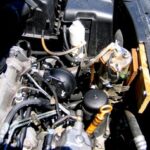Tick Tick tick tick ! My old engine was sounding a bit noisy I thought. And wasn’t the power down a good bit also? And come to think of it..had I not noticed a flutter in the acceleration a time or two..or maybe under a heavy pull like climbing one of these ski slopes we call mountain roads around here? The answer was yes…and I set myself the task of setting a place and time to undertake repairs. This was a classic example of lifters that are worn out and making noise. And the flutter in power I had felt from time to time was also another indication.
Replacing lifters isn’t all that hard when you approach things in the correct way. Set aside plenty of time and have all the parts you are likely to need. In a V engine like mine, the lifters are under the intake manifold. So first I lifted everything off of the manifold that needed to be moved. This included the distributor, various cables and wiring plugs.
With the manifold unbolted and lifted off I had a good view into the center of the engine. There were the lifters. Each in it’s own little socket and resting on the cam. Now I could not simply reach in and pull one of these lifters out. Each one has a push rod sitting right in the middle of it. And the push rod is itself locked down by a a doo-hickey called a tappet. So the valve covers would also have to come off to reveal the tappets. Once those were loose, I would be able to pull the rod out, and then use a pair of needle nose pliers to yank out the lifter.
So what is a lifter anyway? It’s sort of a tiny shock absorber in some ways. Imagine if you will a roll of quarters. Now drill out the center of that roll of coins and leave the one on the bottom intact. Now slide in a roll of nickels through the center of the quarters. . The smaller coins will slide right in there. Now pump in oil from a hole drilled into the side of the larger roll..and you have a lifter. The oil fills the void under the nickels and supports them from resting on the bottom. The push rod will sit in a tiny depression on the top most nickel. The bottom of our lifter rests on the cam shaft. That cam has a lobe, called an eccentric that will come around and “lift” the lifter. And when it does this oil under our nickels will cushion them as they are forced violently up. The push rod resting on the top nickel will cause the tappet it is locked under to pivot. And this tappet will contact the top most portion of a valve…and force it open. Put a lot of these devices together and there you have what is called a valve train. And all engines have them to one degree or another.
This is a V-6 engine so there are two lifters per cylinder and therefore 12 lifters to be swapped out. I should note in passing here that it is a good idea to put the push rods back exactly where they came from…there are wear patterns worn into them and the tappets that should not be changed.
Lifting the valve pans and the tappets doesn’t take long and soon I had the ground around me littered with twelve very used lifters. Plugging in the new lifters was as easy as dropping them in there holes and I then began putting the push rods back in place as well. It wasn’t long before I had cleaned the intake manifold and head surfaces of any remaining gasket materials and cemented the new gaskets in place. With the manifold now dropped back on and bolted down I dropped in the distributor and wired and plugged and hooked everything back the way it came off.
Now it was time for the big moment. I had adjusted the tappets down rather tight as I wanted a good bit of force to be sure the valve would work. Because remember…these were new lifters. And while they were probably pre-charged with oil, who knew how long they had been sitting on the shelf. I wanted to be sure the engine started..even if the lifters were dry of oil. I cranked the engine over and it grudgingly started and ran extremely rough. I let it run for a bit and shut it off. then I went around and gave each tappet a half turn to the left to loosen it up and re-started the engine again. This time it started and ran easier and more smoothly and I left it run on for awhile.
Another go around with the tappets and I let the engine run until it was all the way warm. At this point I left it running and went to each tappet and loosened it until it began making that ticking noise again..and then I tightened it back down until it was quiet once more..and then I gave it a quarter turn more to the right…and that tappet..was now adjusted.
My valves and tappets were all fixed now and I replaced the valve covers once more and drove the vehicle a few times up and down the road to settle things in. The power seemed better and best of all..no ticking noises.




